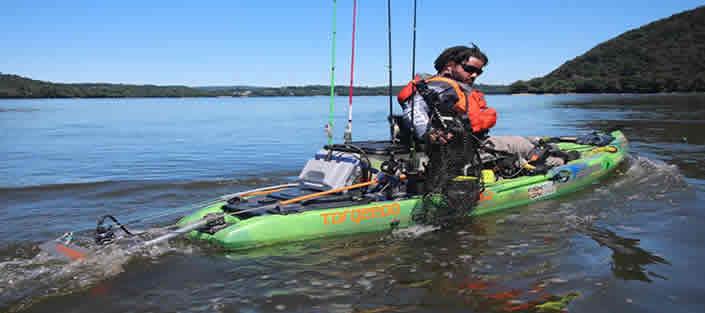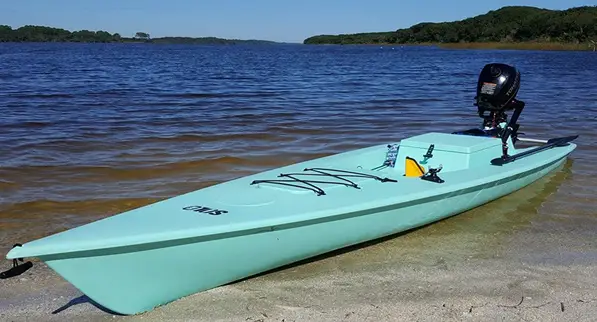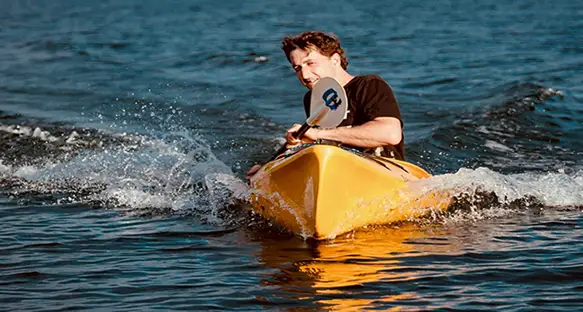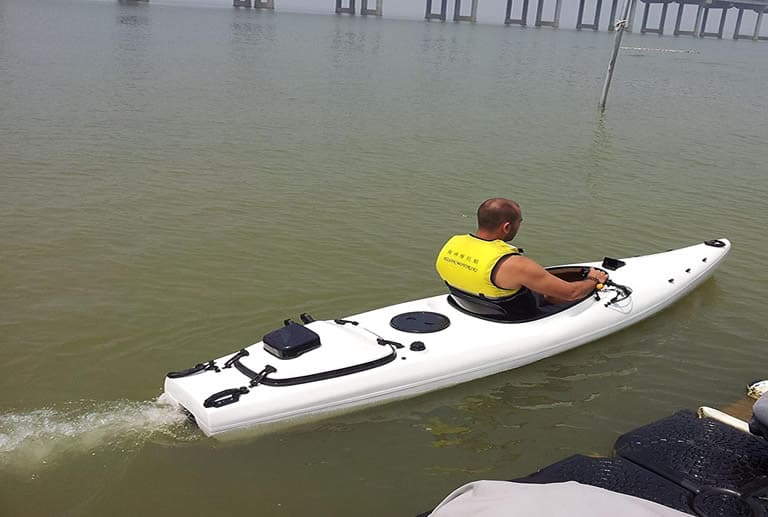Kayaking is is a fun and enjoyable activity that can also help you to stay fit. But many people wonder if there is an alternative way to propel a kayak, especially when their arms and shoulders start aching and they feel exhausted from paddling.
Contents
- Can you put a motor on a kayak? You bet!
- 3 Out-of-the-box motorized kayaks – best motorized kayaks currently on the market
Can you put a motor on a kayak? You bet!
It is possible to put a motor on a kayak. Small trolling motors with a low HP (horse power) are needed as powerful engines will make the kayak difficult to control and too stern heavy.
Electric trolling motors work the best with kayaks because they are lightweight and do not require fuel to be stored onboard.

However, it is not unheard of for a kayak owner to mount a small gas motor on his boat.
If you go down his route then you must be careful.
Gas motors can be dangerous on kayaks, as you will learn in this article.
How to choose the best kayak motor
Although electric trolling motors are the most common type of kayak motor this is not the only option available to you.
The 2 types of kayak motor:
- An electric trolling motor.
- A gas-powered outboard motor.
It is more common to see an electrically powered kayak motor than it is to see a gas powered kayak motor.
Let’s take a look at both approaches to powering a kayak.
You can put an electric motor on a kayak – an electric kayak motor is actually the best choice
Kayak enthusiasts are often in favor of mounting electric trolling motors, which run on a battery system.
A small electric trolling motor can be easily mounted on a kayak.
Low HP electric motors are lightweight and take up very little space on the kayak and so are an ideal way to motorize this small boat.
There are several varieties of electric trolling motor to choose from and in most cases electric-powered motors come in smaller sizes and are lighter in weight than their gas counterparts.
A regular recreational kayak is less than 12 feet and typically weighs less than 50 pounds.
Electric trolling motors weigh between 25 pounds to 80 pounds not including the battery.
So, a small electric trolling motor can be easily mounted on a kayak safely without adding a lot of weight to the boat.
Newer models of electric trolling motors offer a few advantages over gas-powered alternatives as many have a display screen, GPS, and an auto-pilot feature.
Some even allow you to monitor the battery level.
You can put a gas powered motor on a kayak – this type of kayak motor has its disadvantages
An electric trolling motor isn’t the only option available for motorizing a kayak.
Although it is still possible to put a gas-powered motor on a kayak, you will be limited to a very low HP engine.
In order to keep weight low, and be able to carry fuel, a gas motor no bigger than 2 HP should be mounted to a kayak.
However, there are store-bought motorized kayaks with specially mounted engines as high as 9.5 HP.

Although gas powered motors are usually considerably heavier and bulkier than their electric cousins it is possible to mount a small HP gas motor on a kayak.
Some gas-powered trolling motors are actually lighter than an electric trolling motor.
Be aware that if you do want to mount a gas motor then the additional weight of both the motor and the gasoline will be major drawbacks that you must take into account.
This is especially true if you opt for a more powerful motor.
Most gas motors larger than 2 HP will take up a significant amount of space in an already small boat.
They will also be too stern heavy and will probably create too much thrust for a lightweight kayak to be able to handle.
The power output of a larger gas motor can also cause the bow of the kayak to lift out of the water due to the burst of acceleration provided.
This, accompanied by the extra stern weight, can cause a kayak to sink stern first.
How to choose the appropriate kayak motor type and size
Choosing the right motor is crucial and the perfect fit really depends on the design type and the size of your kayak.
Not all kayaks are the same as we outlined in this article.
The bigger the HP (horse power) of a motor the more powerful the thrust will be.
The thrust of trolling motors is generally measured in pounds and the general rule to follow is to maintain two pounds of thrust per 100 pounds of weight.
So you might want to consider the overall weight of your kayak (including gear such as boat camping, hunting and/or fishing equipment that will be onboard) when browsing through a list of suitable motorized engines.
It is also important to note that a motor with a higher thrust will not necessarily give your kayak more speed and instead it may merely work to make your kayak unstable and uncontrollable.
Thrust from a powerful motor can force the stern deeper into the water, lift the front end of the kayak out of the water and send the boat careering out of control.
You only want to mount a low HP gas motor, of no more than 2 HP, on a kayak.
When it comes to electric trolling motors you have more scope for choice. However, you do need to be aware of the weight of the battery.
The more powerful trolling motors will consume more electricity and the batteries available for them are therefore bigger and range from 12 V to 36 V (in increments of 12 V).
There are also electric trolling motors that are designed to run on a dual battery setup and these are obviously not suitable for a small boat like a kayak.
It is prudent to settle for a motor system that only runs on a single battery system so that the overall cost in weight will be reduced.
Most transom mounted electric trolling motors that run on a 12 V battery will be suitable for most types of kayak.
Aside from HP, thrust and power source (gas or electric), there are some other things to consider when choosing a motor for your kayak:
- Shaft length. Kayaks sit pretty low in the water and so you don’t need a overly long propeller shaft on the motor. However, you want the propeller to stay underwater at all times and so you need a long enough shaft to do the job effectively. A shaft length of 24 inches, or 61 centimeters, will usually do the trick.
- Control type. There are several varieties of motor controls to choose from in the market but as a kayaker you will want something with either a tiller handle with extension or a remote control mechanism so you can easily adjust trim and speed while you remain seated and facing forward in your kayak.
Where to mount your new kayak motor
Knowing where to mount a trolling motor on a kayak is not as straight forward as you may imagine.
There are a few places where a motor can be successfully mounted on a kayak.
You can mount trolling motors at either side of the bow or at the transom of the kayak and some people will even mount them at the side gunwales though this is not recommended.

Both bow and stern mounts offers their own advantages and disadvantages.
Here is a quick overview of each type:
- Bow-mount trolling motors are larger than transom motors, which give somewhat better handling, as well as slightly improved maneuvering capability. The downside is that bow-mount trolling motors are more expensive and require more space as they are usually bigger.
- Transom-mount trolling motors are on the cheaper side and they are also smaller compared to their bow-mounted counterparts. A transom-mount trolling motor can be attached with ease using simple clamps. In general, they are an excellent option for small boat users since they don’t take a lot of space and less mass is added to the overall load of the kayak.
Although bow-mount trolling motors are becoming popular, a transom-mount trolling motor is more common because it is cheaper, lighter and and doesn’t take up as much space.
The many advantages of mounting a kayak motor
Are there any real advantages to putting a motor on a kayak? After all isn’t kayaking all about paddling?
Paddling is by far the most popular way to enjoy the overall experience of kayaking and it is the traditional.
The humble paddle has been used to both steer and propel the kayak for centuries for a reason – it works!
So why add a motor to an already perfect setup?
The modern kayak has evolved from the traditional Inuit fishing vessel but since those early boats many designs changes have been made and we have embraced these changes.
The new hull design characteristics of modern kayaks make these small boats incredibly versatile vessels.
They are capable of multiple different tasks from touring and ocean use to fishing and recreational pursuits to whitewater sports depending on their specific design.
The kayak is continuing to evolve so why should we not also embrace its ability to use modem propulsion methods like a motor?
Putting a motor on your kayak, whether electric or gasoline-powered, is just an innovative way to get more from kayaking.
3 Out-of-the-box motorized kayaks – best motorized kayaks currently on the market
Many varieties of motorized kayaks have now flooded the market as demand for a more mechanized approach to kayaking increases.
The commercial success of earlier designs of motorized kayaks, and the growing number of people who are making their own motorized modifications to their kayaks, have boosted innovations in the kayaking industry.
Manufacturers bow strive to meet the demand in the marketplace for a motorized kayak option.
Although there are a growing number of motorized kayaks to choose from several models are worth mentioning here.
1. The Mokai Es-Kape 2.0 – best motorized kayak for rough water
This motorized kayak boasts a modular hull component that users can keep as a single monocoque or can be disassembled for easy storage and transportation.
This watercraft promises to be beginner-friendly, and is lightweight and easy to transport. In addition is is environmentally friendly and fuel-efficient.
This type of motorized kayak is perfect for upstream travelling in shallow calm waters.
It can travel at speeds over 20 miles per hour using its Command PRO CH395 9.5 HP gas engine and can cover over 40-mile with its 4.0-gallon gas tank.
The Mokai Es-Kape 2.0 motorized kayak in rough water (video)
2. Wilderness Systems Radar 115 – best motorized kayak for beginners
Another noteworthy motorized kayak available on the market with a much more affordable price tag is the Wilderness Systems Radar 115 kayak.
The Radar 115 kayak can be used with a traditional paddle, or fitted with the helix pedal drive and/or the helix MD motor.
Unlike the Mokai Es-Kape 2.0, the hull of Wilderness Systems Radar kayak cannot be disassembled for compact storage making it a little less storage-friendly.
Wilderness Systems Radar 115 motorized kayak walkthrough (video)
3. Old Town Predator MK – best motorized kayak for fishing
Another motorized kayak worth mentioning is Old Town Predator MK Fishing Kayak.
This kayak can carry up to 600 pounds load capacity which is much more weight than typical kayaks can accommodate.
It can also accommodate more storage and has more mounting options with a hull built at 13 feet 2 inches in length and 36 inches in width.
This motorized kayak offers completely hands-free navigation and trolling using its Minn Kota MK motor. It comes with various speed control and forward/reverse capabilities via a foot-controlled rudder.

